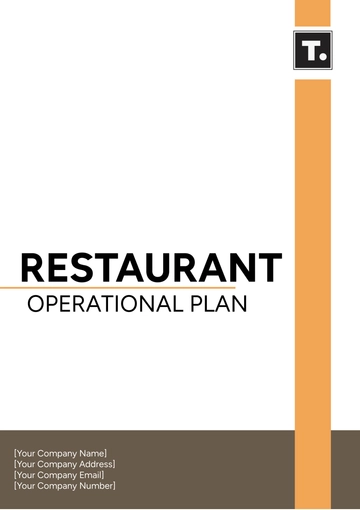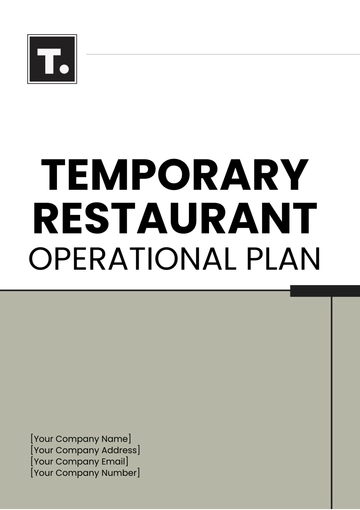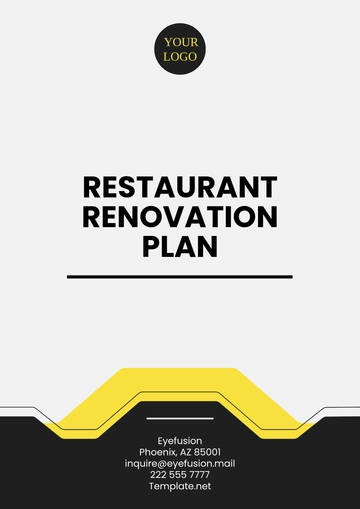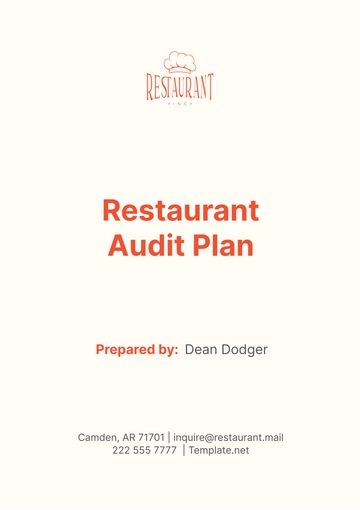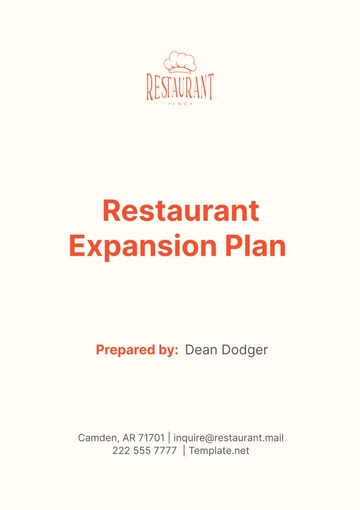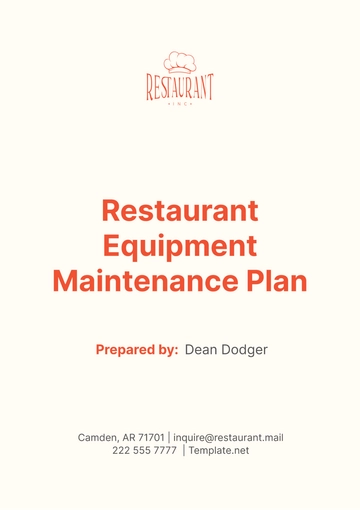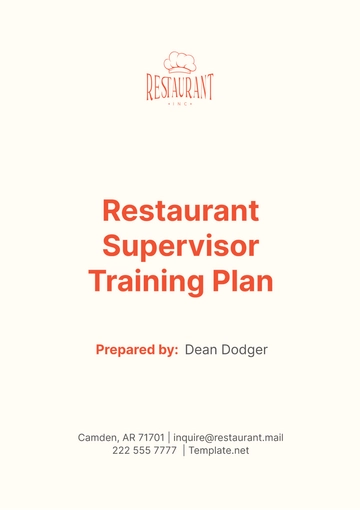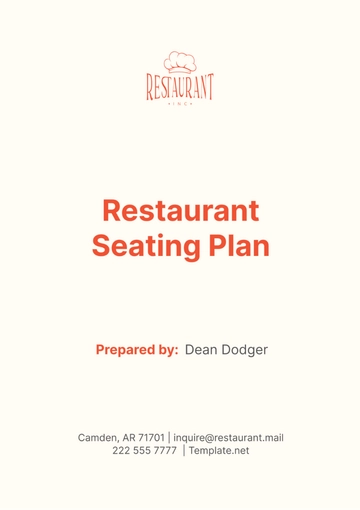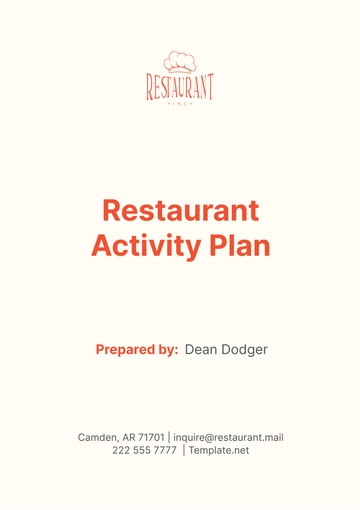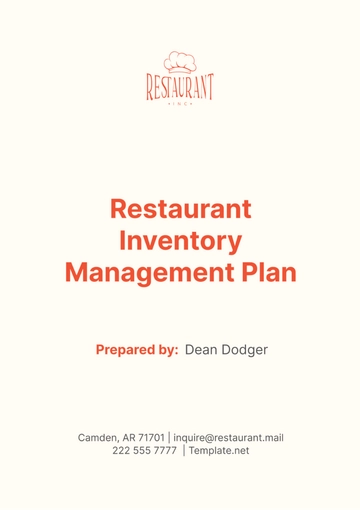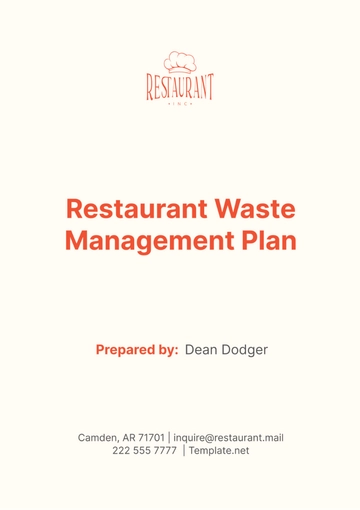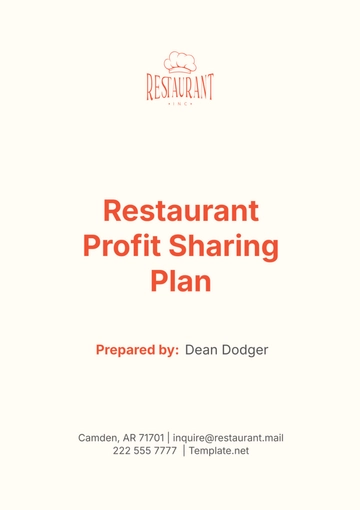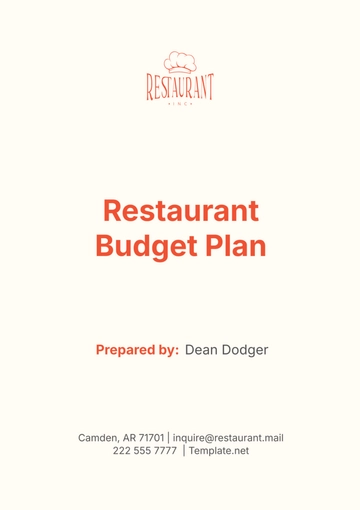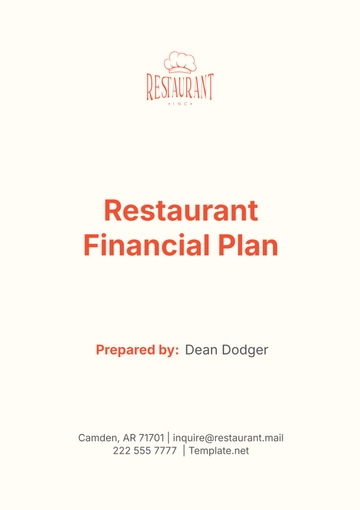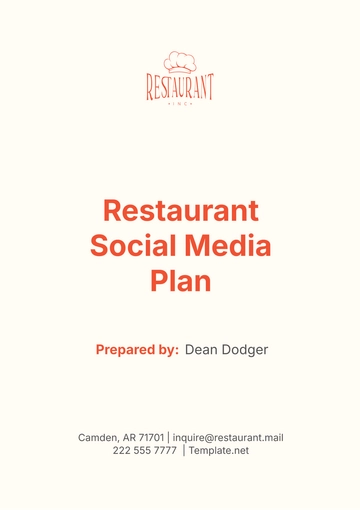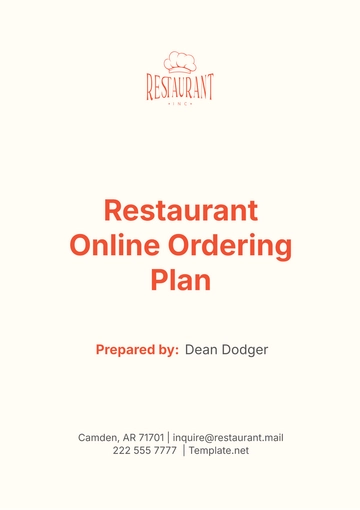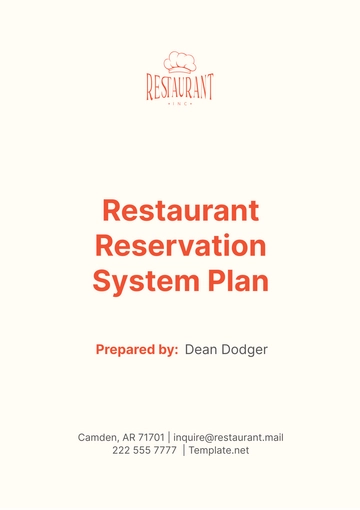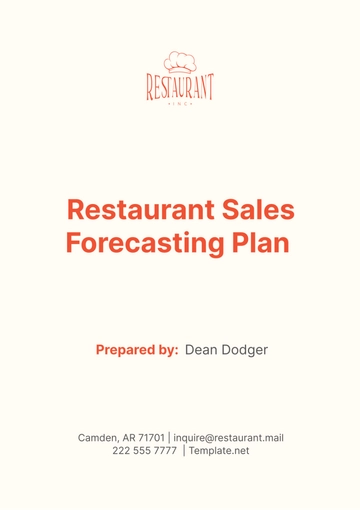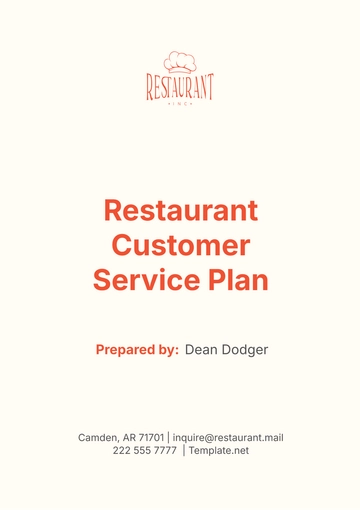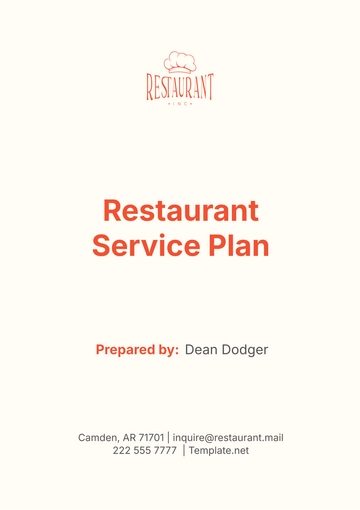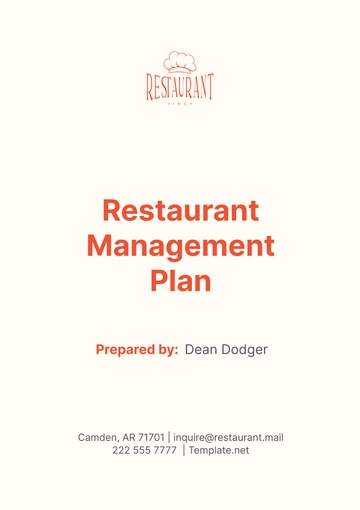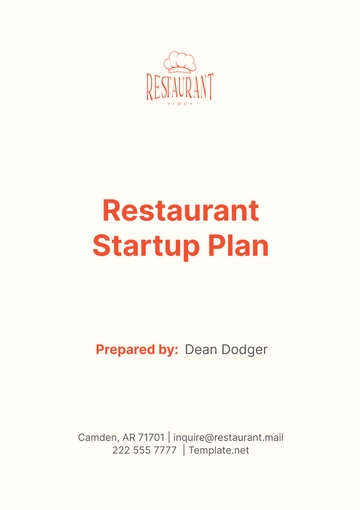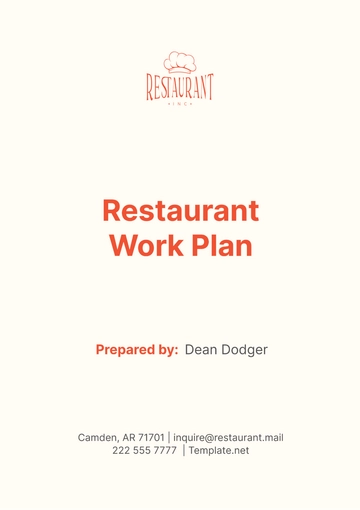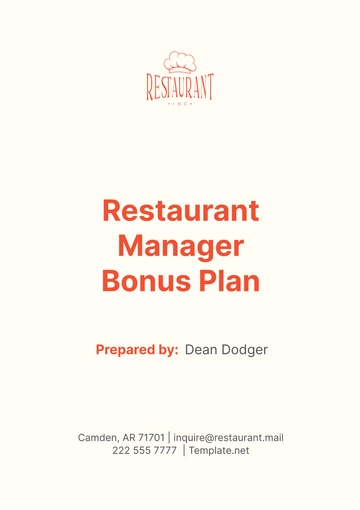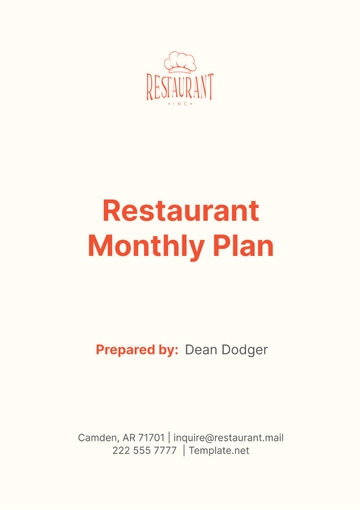Free Restaurant Financial Plan
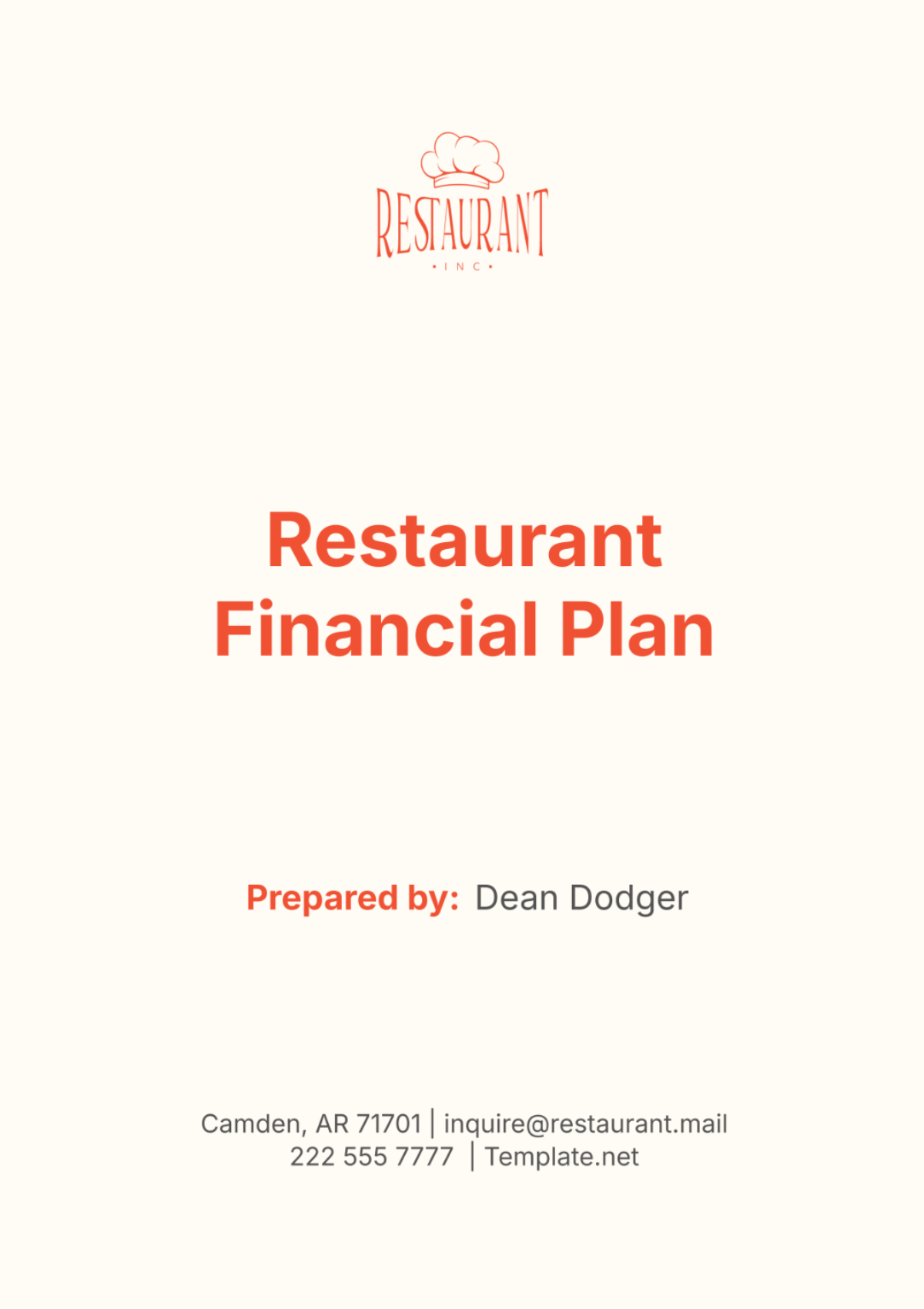
I. Executive Summary
The Restaurant Financial Plan for [Your Company Name] serves as a comprehensive guide to achieving financial stability and growth. By outlining precise financial goals, allocating budgets effectively, and forecasting future financial performance, this plan is designed to optimize operational efficiency, enhance profitability, and support future expansion initiatives. Our approach ensures that every financial decision aligns with our strategic objectives and long-term vision.
To achieve our revenue growth targets, we will focus on maintaining strong profit margins, controlling operational costs, and implementing a robust capital investment strategy. This includes investments in kitchen equipment, dining area enhancements, and staff training programs that improve service quality and customer satisfaction. Establishing financial reserves will also provide a cushion for unforeseen expenses, ensuring the restaurant’s resilience in fluctuating market conditions.
Regular financial reviews, conducted monthly and quarterly, will be crucial in monitoring our progress and making necessary adjustments. These reviews will allow us to stay agile, address any financial discrepancies promptly, and refine our strategies to meet evolving business challenges and opportunities. Through disciplined financial management, [Your Company Name] is poised to achieve sustained growth and long-term success in the competitive restaurant industry.
II. Financial Objectives
Our financial objectives are designed to ensure the sustained growth and profitability of [Your Company Name]. By targeting key areas such as revenue growth, profit margins, operating expenses, capital investments, and financial reserves, we aim to create a solid financial foundation. This section outlines our specific financial targets and the strategic actions required to achieve them, ensuring that our financial health remains robust and resilient.
Objective | Description | Target Outcome | Strategy |
|---|---|---|---|
Achieve Revenue Targets | Aim for an annual revenue growth of 15%, reaching $1.5 million by the end of the third year. | Strategic marketing efforts and enhanced customer experiences will drive this growth. | Invest in targeted marketing campaigns and enhance the dining experience to attract and retain customers. |
Maintain Profit Margins | Maintain gross profit margins above 65% and net profit margins at or above 10%. | Achieve high profitability through meticulous cost management and operational efficiency. | Optimize menu prices, reduce waste, and streamline operations to enhance efficiency and cost-effectiveness. |
Control Operating Expenses | Limit total operating expenses to less than 30% of total revenue. | Prudent budgeting and regular expense reviews will help achieve this goal. | Implement strict budgeting practices and conduct regular reviews to monitor and manage expenses. |
Capital Investment Strategy | Allocate $300,000 for initial setup and renovations, focusing on high ROI improvements. | Improve kitchen efficiency and enhance dining area to boost customer satisfaction and operational efficiency. | Invest in modern kitchen equipment and refurbish the dining area to create a more appealing environment. |
Establish Financial Reserves | Build a cash reserve of $100,000 by the end of year two. | Mitigate risks and support future expansions through a robust financial buffer. | Set aside a portion of profits each month to steadily build the reserve and ensure financial stability. |
III. Revenue Forecast
Our revenue forecast provides a detailed roadmap for [Your Company Name]'s financial planning over the next three years. By projecting growth based on anticipated customer increases, market trends, and strategic initiatives, we ensure a clear vision for future financial stability and success. This forecast helps us align our resources and efforts to meet our revenue targets and drive sustained growth.
Year | Projected Revenue | Key Assumptions | Strategies |
|---|---|---|---|
Year 1 | $1 million | Initial customer base establishment, positive market reception, and foundational marketing efforts. | Launch targeted marketing campaigns, enhance customer experience, and establish a loyal customer base. |
Year 2 | $1.2 million | Continued customer growth, increased brand awareness, and market expansion. | Expand marketing reach, introduce new menu items, and optimize service efficiency to attract more customers. |
Year 3 | $1.5 million | Mature market presence, strong customer loyalty, and enhanced operational efficiency. | Leverage customer loyalty programs, refine marketing strategies, and continuously improve operations. |
This revenue forecast is underpinned by several key factors:
Anticipated Customer Growth: We expect a steady increase in our customer base due to our strategic marketing initiatives and enhanced dining experience. Customer loyalty programs and word-of-mouth referrals will also contribute to this growth.
Market Trends: By staying ahead of industry trends and adapting to changing consumer preferences, we will position ourselves as a leading choice in the market. This includes menu innovation, sustainable practices, and leveraging digital marketing.
Marketing and Operational Strategies: Successful implementation of our marketing strategies, such as targeted campaigns, promotions, and partnerships, will drive revenue growth. Additionally, optimizing our operational efficiency will reduce costs and improve customer satisfaction, leading to higher sales and repeat business.
Our proactive approach to revenue forecasting ensures that [Your Company Name] remains financially healthy and prepared for future opportunities and challenges.
IV. Budget Allocation
Our budget allocation strategy is meticulously crafted to maximize impact and ensure operational efficiency for [Your Company Name]. By distributing resources across key areas, we aim to support growth, enhance customer experiences, and maintain financial stability. This comprehensive allocation plan ensures that every dollar is spent wisely, driving our business forward while maintaining fiscal responsibility.
Category | Allocation Amount | Purpose | Key Strategies |
|---|---|---|---|
Initial Capital Expenditure | $300,000 | Renovations, kitchen equipment, and initial inventory to set up and enhance the restaurant. | Invest in high-quality kitchen equipment, modernize dining areas, and stock initial inventory effectively. |
Marketing and Advertising | 10% of annual revenue | Drive brand awareness and customer acquisition through strategic marketing efforts. | Implement targeted marketing campaigns, utilize social media, and partner with influencers. |
Labor Costs | 25% of total revenue | Cover wages, training, and benefits to attract and retain skilled staff. | Provide competitive salaries, offer comprehensive training programs, and maintain employee satisfaction. |
Operational Expenses | 15% of total revenue | Manage utilities, rent, maintenance, and other essential operational costs. | Negotiate favorable contracts, monitor utility usage, and ensure regular maintenance to control costs. |
Miscellaneous Contingency Fund | 5% of total revenue | Address unforeseen costs and seize unexpected opportunities. | Maintain a flexible fund to quickly respond to emergencies or capitalize on new opportunities. |
Initial Capital Expenditure: The $300,000 allocated for initial capital expenditure will be invested in high-impact areas such as state-of-the-art kitchen equipment, stylish dining area renovations, and essential initial inventory. These investments are crucial for creating an appealing environment and ensuring efficient operations from day one.
Marketing and Advertising: Allocating 10% of our annual revenue to marketing and advertising will help us build brand awareness and attract a steady stream of customers. We will employ a mix of digital marketing, social media campaigns, and strategic partnerships to maximize our reach and impact. Regular assessments of our marketing strategies will ensure they remain effective and aligned with our business goals.
Labor Costs: By dedicating 25% of our total revenue to labor costs, we aim to attract and retain top talent. This includes competitive wages, comprehensive training programs, and attractive benefits packages. Investing in our staff will improve service quality, boost employee satisfaction, and reduce turnover, ultimately enhancing the overall customer experience.
Operational Expenses: Managing operational expenses at 15% of total revenue will involve careful budgeting for utilities, rent, and maintenance. Regular reviews and optimizations of these expenses will help us maintain a cost-efficient operation, ensuring that resources are utilized effectively without compromising service quality.
Miscellaneous Contingency Fund: Setting aside 5% of total revenue for a miscellaneous contingency fund will provide a financial buffer for unforeseen expenses and opportunities. This fund will allow us to quickly address unexpected challenges or invest in new opportunities that arise, ensuring our financial stability and flexibility.
By strategically allocating our budget across these essential areas, we ensure balanced growth, operational efficiency, and the financial stability necessary for [Your Company Name] to thrive in the competitive restaurant industry.
V. Break-even Analysis
Our break-even analysis projects that [Your Company Name] will achieve break-even within 18 months post-launch. This timeline is grounded in our initial financial forecasts and hinges on the successful execution of our strategic initiatives. By closely monitoring costs and making necessary adjustments, we aim to not only reach but surpass the break-even point, setting a strong foundation for profitability.
Metric | Target | Key Assumptions | Strategies |
|---|---|---|---|
Break-even Timeline | Month 18 | Based on initial revenue and expense forecasts, assuming successful implementation of strategic initiatives. | Implement cost control measures, optimize pricing strategies, and enhance customer acquisition efforts. |
Initial Forecasts | Projected revenue and expenses | Revenue growth from marketing efforts, operational efficiency, and customer satisfaction. | Execute marketing campaigns, streamline operations, and focus on exceptional customer service. |
Cost Strategies | Continuous monitoring and adjustment | Maintaining cost efficiency through regular reviews and strategic adjustments. | Conduct monthly and quarterly financial reviews, optimize resource allocation, and reduce waste. |
Financial Reviews | Regular reviews and adjustments | Key milestones tracked to ensure alignment with financial goals and prompt response to deviations. | Establish a schedule for financial reviews, set performance benchmarks, and adjust strategies as needed. |
Break-even Timeline: Achieving break-even within 18 months requires precise execution of our strategic plans. This involves increasing revenue through effective marketing and maintaining tight control over costs. By month 18, we anticipate our revenue will match our expenses, marking a significant milestone towards profitability.
Initial Forecasts: Our break-even analysis is based on detailed revenue and expense forecasts. These forecasts assume steady revenue growth driven by our marketing initiatives, operational efficiencies, and enhanced customer experiences. We will continuously refine these forecasts to reflect actual performance and market conditions.
Cost Strategies: Continuous monitoring and adjustment of our cost strategies are crucial to reaching our break-even point. We will implement cost control measures, optimize pricing strategies, and enhance our operational efficiency to keep expenses in check. Regular reviews will help identify areas for cost reduction and ensure we remain on track.
Financial Reviews: Regular financial reviews will be conducted to track our progress towards break-even. Key milestones will be monitored to ensure alignment with our financial goals. Any deviations from our plan will be promptly addressed through targeted adjustments, ensuring we stay on course towards achieving profitability.
By maintaining a disciplined approach to financial management and proactively addressing any challenges, [Your Company Name] is well-positioned to achieve break-even within the projected timeframe and build a solid foundation for sustained profitability and growth.
VI. Financial Controls
To ensure financial discipline and accuracy, [Your Company Name] will implement robust financial controls. These measures will enable us to track performance, make timely adjustments, and maintain financial integrity. By staying aligned with our financial goals, we can make informed decisions that support business sustainability and growth, fostering long-term success.
Control Measure | Frequency | Purpose | Key Strategies |
|---|---|---|---|
Monthly Financial Reviews | Monthly | Track revenue and expenses against forecasts to ensure alignment with financial goals. | Conduct detailed monthly reviews, compare actuals to forecasts, and identify areas for improvement. |
Quarterly Adjustments | Quarterly | Make necessary budget adjustments based on operational performance and market dynamics. | Analyze quarterly performance, adjust budgets, and reallocate resources as needed to optimize results. |
Annual Financial Audits | Annually | Ensure accuracy, compliance, and financial integrity through thorough audits by [Your Company Name]. | Engage external auditors if necessary, review financial statements, and implement audit recommendations. |
Monthly Financial Reviews: Monthly financial reviews will be conducted to closely monitor our revenue and expenses. By comparing actual performance against forecasts, we can quickly identify any discrepancies and take corrective actions. This proactive approach ensures that we stay on track with our financial goals and maintain operational efficiency.
Quarterly Adjustments: Quarterly adjustments to the budget will be made based on our operational performance and market dynamics. This allows us to respond to changes in the business environment and optimize resource allocation. Regular analysis of quarterly results will help us refine our strategies and ensure that we remain agile and adaptive to new opportunities and challenges.
Annual Financial Audits: Annual financial audits will be conducted to ensure the accuracy, compliance, and integrity of our financial records. These thorough audits by [Your Company Name] will help us maintain transparency and accountability. By implementing the audit recommendations, we can strengthen our financial controls and enhance our overall financial health.
These financial controls are designed to keep [Your Company Name] aligned with its financial goals and to support informed decision-making. By maintaining a disciplined approach to financial management, we can ensure business sustainability and drive growth, securing our position in the competitive restaurant industry.
VII. Conclusion
The Restaurant Financial Plan is a strategic framework designed to manage financial resources effectively, ensuring sustainable growth, profitability, and long-term success for [Your Company Name]. By focusing on careful budgeting, regular financial reviews, and targeted investments, we aim to maintain a competitive edge in the dynamic food and beverage industry. This plan provides a clear roadmap to navigate financial challenges and seize opportunities for growth.
Adhering to this plan will help us build a robust financial foundation that supports our vision of becoming a leading brand in the market. We are committed to constant evaluation and strategic adjustments, allowing us to respond proactively to market changes and evolving customer preferences. This disciplined approach will enable us to achieve our financial objectives and drive sustained business success.
Through diligent financial management and strategic foresight, [Your Company Name] is well-positioned to thrive in the competitive landscape. Our commitment to excellence and continuous improvement will ensure that we not only meet but exceed our financial goals, securing a prosperous future for our business. This comprehensive plan underscores our dedication to financial stability and growth, setting the stage for long-term achievement and industry leadership.
- 100% Customizable, free editor
- Access 1 Million+ Templates, photo’s & graphics
- Download or share as a template
- Click and replace photos, graphics, text, backgrounds
- Resize, crop, AI write & more
- Access advanced editor
Elevate your restaurant's success with Template.net's Restaurant Financial Plan Template. This fully editable and customizable template is designed to streamline your financial planning process. Editable in our AI Editor Tool, it's easy to tailor to your specific needs. Experience seamless budgeting and forecasting. Start making informed financial decisions today, ensuring your restaurant's profitability and growth.
You may also like
- Finance Plan
- Construction Plan
- Sales Plan
- Development Plan
- Career Plan
- Budget Plan
- HR Plan
- Education Plan
- Transition Plan
- Work Plan
- Training Plan
- Communication Plan
- Operation Plan
- Health And Safety Plan
- Strategy Plan
- Professional Development Plan
- Advertising Plan
- Risk Management Plan
- Restaurant Plan
- School Plan
- Nursing Home Patient Care Plan
- Nursing Care Plan
- Plan Event
- Startup Plan
- Social Media Plan
- Staffing Plan
- Annual Plan
- Content Plan
- Payment Plan
- Implementation Plan
- Hotel Plan
- Workout Plan
- Accounting Plan
- Campaign Plan
- Essay Plan
- 30 60 90 Day Plan
- Research Plan
- Recruitment Plan
- 90 Day Plan
- Quarterly Plan
- Emergency Plan
- 5 Year Plan
- Gym Plan
- Personal Plan
- IT and Software Plan
- Treatment Plan
- Real Estate Plan
- Law Firm Plan
- Healthcare Plan
- Improvement Plan
- Media Plan
- 5 Year Business Plan
- Learning Plan
- Marketing Campaign Plan
- Travel Agency Plan
- Cleaning Services Plan
- Interior Design Plan
- Performance Plan
- PR Plan
- Birth Plan
- Life Plan
- SEO Plan
- Disaster Recovery Plan
- Continuity Plan
- Launch Plan
- Legal Plan
- Behavior Plan
- Performance Improvement Plan
- Salon Plan
- Security Plan
- Security Management Plan
- Employee Development Plan
- Quality Plan
- Service Improvement Plan
- Growth Plan
- Incident Response Plan
- Basketball Plan
- Emergency Action Plan
- Product Launch Plan
- Spa Plan
- Employee Training Plan
- Data Analysis Plan
- Employee Action Plan
- Territory Plan
- Audit Plan
- Classroom Plan
- Activity Plan
- Parenting Plan
- Care Plan
- Project Execution Plan
- Exercise Plan
- Internship Plan
- Software Development Plan
- Continuous Improvement Plan
- Leave Plan
- 90 Day Sales Plan
- Advertising Agency Plan
- Employee Transition Plan
- Smart Action Plan
- Workplace Safety Plan
- Behavior Change Plan
- Contingency Plan
- Continuity of Operations Plan
- Health Plan
- Quality Control Plan
- Self Plan
- Sports Development Plan
- Change Management Plan
- Ecommerce Plan
- Personal Financial Plan
- Process Improvement Plan
- 30-60-90 Day Sales Plan
- Crisis Management Plan
- Engagement Plan
- Execution Plan
- Pandemic Plan
- Quality Assurance Plan
- Service Continuity Plan
- Agile Project Plan
- Fundraising Plan
- Job Transition Plan
- Asset Maintenance Plan
- Maintenance Plan
- Software Test Plan
- Staff Training and Development Plan
- 3 Year Plan
- Brand Activation Plan
- Release Plan
- Resource Plan
- Risk Mitigation Plan
- Teacher Plan
- 30 60 90 Day Plan for New Manager
- Food Safety Plan
- Food Truck Plan
- Hiring Plan
- Quality Management Plan
- Wellness Plan
- Behavior Intervention Plan
- Bonus Plan
- Investment Plan
- Maternity Leave Plan
- Pandemic Response Plan
- Succession Planning
- Coaching Plan
- Configuration Management Plan
- Remote Work Plan
- Self Care Plan
- Teaching Plan
- 100-Day Plan
- HACCP Plan
- Student Plan
- Sustainability Plan
- 30 60 90 Day Plan for Interview
- Access Plan
- Site Specific Safety Plan


